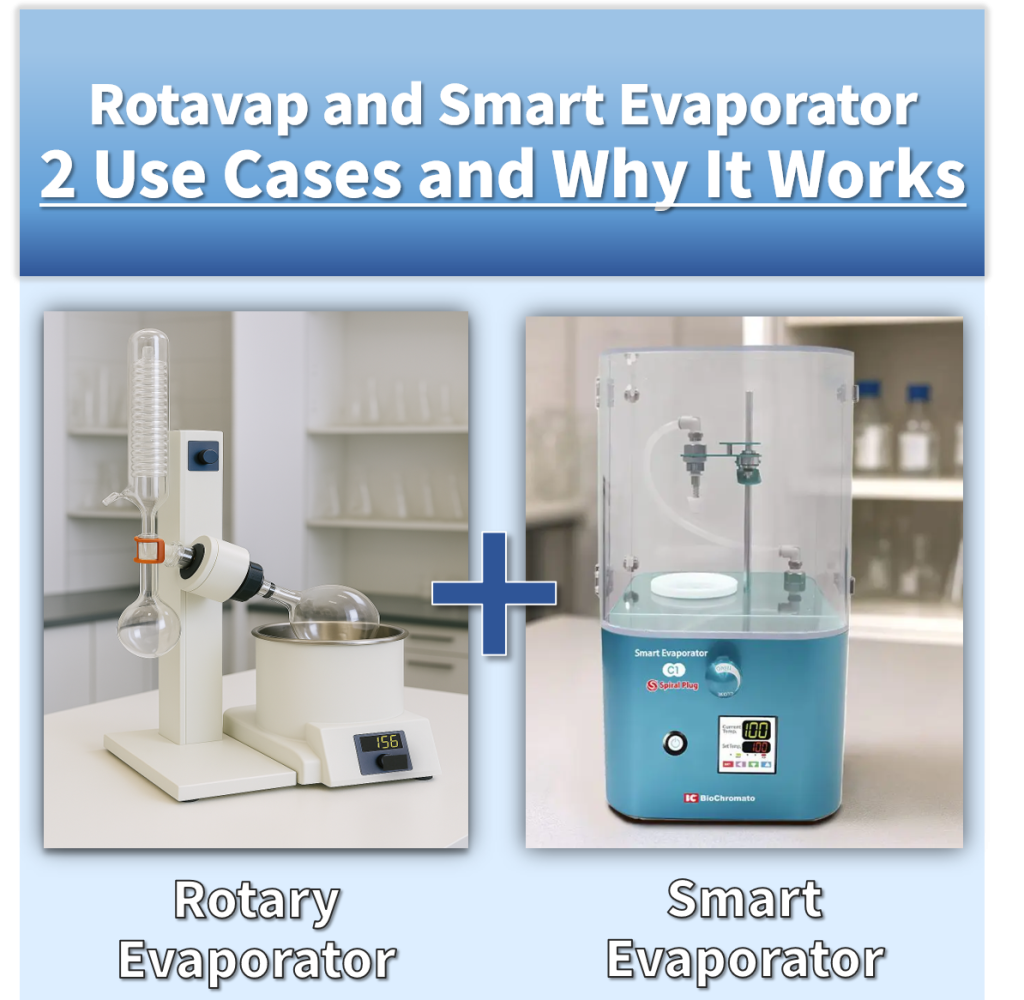Rotavap and Smart Evaporator: 2 Use Cases and Why It Works

Introduction
In today’s research laboratories, solvent evaporation is a routine yet critical step—one that must balance efficiency, sample integrity, and operational safety. While rotary evaporators remain the go-to solution for large-volume solvent removal, Smart Evaporators offer a unique edge in handling small-volume, high-boiling solvents with minimal supervision and no risk of bumping.
But what happens when you use both systems together?
This article explores two real-world examples of laboratories that have successfully combined rotary and Smart Evaporators. We’ll break down how each device is applied, why the combination improves productivity, and how your own workflow might benefit from a dual setup.
Table of Contents
- Why Combine Rotavap and Smart Evaporators?
- Case 1: Lipid Synthesis – University of Tokyo
- Case 2: Organic Synthesis – Meiji University
- Why This Combination Makes Sense
- Conclusion: Dual Setup, Smarter Lab Operations
- Frequently Asked Questions (FAQ)
Ready for Safer, Faster, and More Reliable Evaporation?
1. Why Combine Rotavap and Smart Evaporators?
While rotary evaporators are ideal for evaporating large volumes of volatile solvents under reduced pressure, Smart Evaporators excel at safely concentrating small volumes of high-boiling solvents—without bumping, and often directly in small sample containers like vials or tubes.
Combining both systems allows researchers to:
- Match the right evaporator to the right sample
- Avoid unnecessary sample transfers
- Increase throughput across diverse workflows
2. Case 1: Lipid Synthesis – University of Tokyo
“We’re using Smart Evaporator and rotary evaporator together in the work of phospholipid synthesis.”
— Dr. Satoshi Honda, Assistant Professor, The University of Tokyo
Source: Testimonial No.33 – BioChromato Official Website
In his lipid synthesis workflows, Dr. Honda first removes large volumes of solvents using a rotary evaporator. For the final stages—especially when sample volumes are small or the solvent boiling points are high—he switches to the Smart Evaporator to prevent bumping and save time.
Ready for Safer, Faster, and More Reliable Evaporation?
3. Case 2: Organic Synthesis – Meiji University
“I am going to use Smart Evaporator and rotary evaporator for each experiment and process.”
— Mr. Takeo Kurata, Meiji University
Source: Testimonial No.6 – BioChromato Official Website
At Meiji University, Mr. Takeo Kurata uses rotary evaporators for bulk solvent removal in organic synthesis. However, when working with high-boiling-point solvents such as DMSO, he turns to the Smart Evaporator to avoid bumping and streamline the final concentration process.
Ready for Safer, Faster, and More Reliable Evaporation?
4. Why This Combination Makes Sense
| Use Case / Condition | Rotary Evaporator | Smart Evaporator |
|---|---|---|
| Low-boiling solvents (bulk volume) | ✅ Best fit | △ Less efficient for large volumes |
| Low-boiling solvents (small volume) | △ May bump; setup can be time-consuming | ✅ Best fit – direct vial evaporation |
| High-boiling solvents
| △ Slow / risk of bumping | ✅ Fast & bump-free |
| Multi-sample (simultaneous evaporation) | △ Manual, 1–2 at a time | ✅ Up to 10 vials (C10 model) |
| Direct evaporation in vials or tubes | ❌ Requires transfer | ✅ Supported |
| Supervision needed? | △ Yes – manual monitoring | ✅ No – safe unattended operation |
Note: Rotary evaporators are ideal for large-volume samples with low-boiling solvents. For small-volume or high-boiling solvents—especially when working with vials or multiple samples—Smart Evaporators offer greater efficiency, safety, and hands-free operation.
5. Conclusion: Dual Setup, Smarter Lab Operations
Rotary and Smart Evaporators are not rivals—they are complementary tools. Together, they enable safer, faster, and more versatile evaporation workflows.
If your laboratory handles a diverse range of solvents, volumes, or container types, incorporating both systems is not just possible—it may be the smartest and most efficient approach. Rather than choosing one over the other, a dual setup enables you to harness the strengths of both and optimize your workflow from start to finish.
6. Frequently Asked Questions (FAQ)
Q1. Can I use a rotary evaporator and Smart Evaporator together?
Yes. Many researchers use both devices in their workflows. Rotary evaporators are ideal for large-scale solvent removal, while Smart Evaporators excel at handling small volumes of high-boiling solvents or sensitive samples.
Q2. What’s the biggest difference between rotary and Smart Evaporators?
Rotary evaporators use vacuum and rotation to evaporate solvents, making them great for bulk removal. Smart Evaporators use a vortex method at atmospheric pressure, making them better for bumping-free evaporation, especially with solvents like DMSO, DMF, or water.
Q3. Is Smart Evaporator suitable for high-boiling-point solvents?
Absolutely. That’s where it shines. Smart Evaporator can handle a wide range of solvents—both low- and high-boiling-point—without bumping. From volatile solvents to challenging ones like DMSO or water, it enables smooth evaporation regardless of boiling point, something that is often difficult with rotary evaporators or freeze dryers.
Q4. How many samples can Smart Evaporator handle at once?
Depending on the model, the Smart Evaporator can process up to 10 samples simultaneously (e.g., the C10 model), making it highly efficient for multi-sample workflows.
In the near future, an automated model capable of handling up to 140 samples is also expected to be released, further enhancing its suitability for high-throughput workflows.
Q5. Do I need special glassware for Smart Evaporator?
No. One of the advantages of the Smart Evaporator is its vessel flexibility. You can evaporate directly in vials, tubes, or flasks without needing dedicated glassware.
Ready for Safer, Faster, and More Reliable Evaporation?
